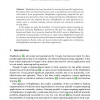Free Online Productivity Tools
i2Speak
i2Symbol
i2OCR
iTex2Img
iWeb2Print
iWeb2Shot
i2Type
iPdf2Split
iPdf2Merge
i2Bopomofo
i2Arabic
i2Style
i2Image
i2PDF
iLatex2Rtf
Sci2ools
APPT
2009
Springer
2009
Springer
Evaluating SPLASH-2 Applications Using MapReduce
MapReduce has been prevalent for running data-parallel applications. By hiding other non-functionality parts such as parallelism, fault tolerance and load balance from programmers, MapReduce significantly simplifies the programming of large clusters. Due to the mentioned features of MapReduce above, researchers have also explored the use of MapReduce on other application domains, such as machine learning, textual retrieval and statistical translation, among others. In this paper, we study the feasibility of running typical supercomputing applications using the MapReduce framework. We port two applications (Water Spatial and Radix Sort) from the Stanford SPLASH-2 suite to MapReduce. By completely evaluating them in Hadoop, an open-source MapReduce framework for clusters, we analyze the major performance bottleneck of them in the MapReduce framework. Based on this, we also provide several suggestions in enhancing the MapReduce framework to suite these applications.
APPT 2009 | Distributed And Parallel Programming | MapReduce Framework | Open-source Mapreduce Framework | Typical Supercomputing Applications |
| Added | 25 May 2010 |
| Updated | 25 May 2010 |
| Type | Conference |
| Year | 2009 |
| Where | APPT |
| Authors | Shengkai Zhu, Zhiwei Xiao, Haibo Chen, Rong Chen, Weihua Zhang, Binyu Zang |
Comments (0)

